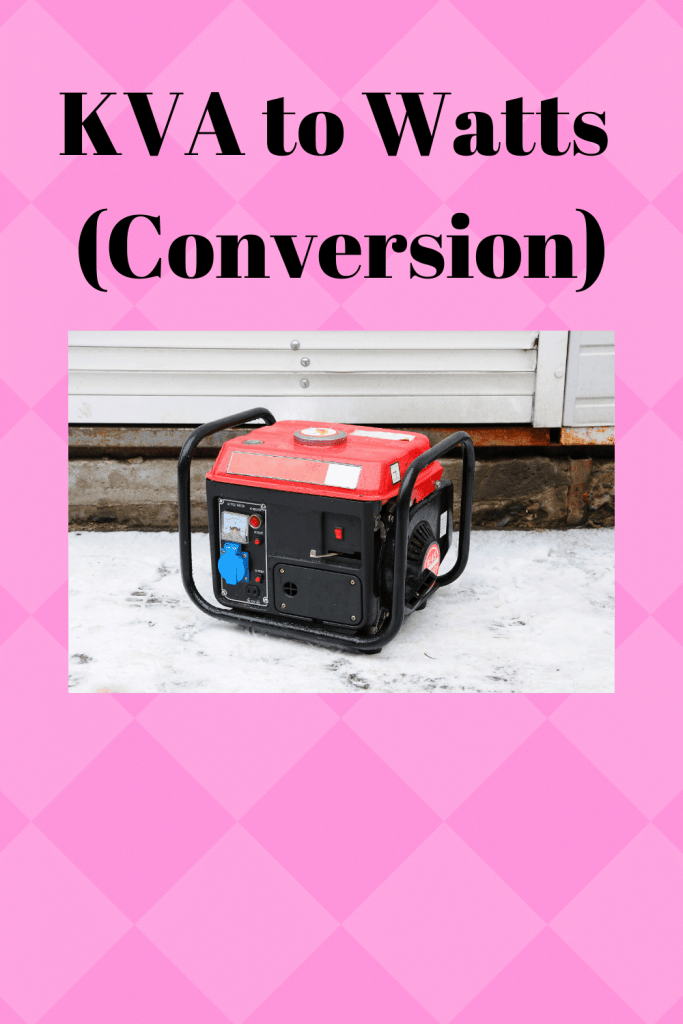KVA to Watts Overview
Conversion of Watts to KVA
Formula
The actual power p given in watts (W) is an equivalent of 1000 times the patent power S given in kilovolt-amps (kVA), multiplied by the power it is raised to PF:
S (kVA) =P (W)/ (1000 XPF)
Therefore, watts are equivalent to 1000 times kilovolt-amps multiplied by the power factor.
Watts=1000 x kilovolt amps X PF
Or
W=1000 x kVA X PF
As a common principle, you need to multiply the number of VA by .6 to change Watts’s standards. Therefore 1000VA UPS is set to work with a 600-Watt load.
100VA will thus be;
100 x0.6 =60-Watt load
The power factor is what determines if 1kva can be 1000 watts or zero watts. The change in stage relationship between voltage and electric current may also be instigated by characteristics such as electrical capacity or induction in ac circuits. In a strictly electrically resistive system, 1kva =1000w. However, in many systems, we find capacitive and inductive constituents that make current to speed or retard voltage respectively.

A 5kva generator machine at unity control aspect (0.1), the extreme output is 5000 watts (volts x amps x current aspect factor/1000) but at 0.8 power aspect (some commelinids generator) it will be 4000 watts. Constant consecutively power is usually 80% of that supreme output, so 4000w (0.8 power factor) has a nonstop 3200 running.
The main difference between kilovolt-ampere and kilowatt lies in the power to which it is raised. Kilowatt is used in determining actual power (or actual power combined with the reactive power. The kilovolt-amperes refer to the generator and its load.
Except in cases where it is characterized, the power factor is thus an estimated number (typically 0.8). The kilovolt-amperes value will be more than the value of kilowatt at all times.
Electrical and electronic equipment is accompanied by electrical standards operational degrees on the nameplate. Changing this information into analyzable information is saves a great deal. For instance, if you are computing power in kilovolts- amperes(kVA) the nameplate can enlighten you on voltages, amperes, power in watts, power factor, or certain correlations.
You can compute using uncomplicated power relationship criteria to change basic information to kVA.
Compute power standards in kilovolts-amperes, or kVA, awareness of the voltage and the current standards. Make use of the formula: P (kVA) =VA/1000. In this case, P (kVA) is the power given in kVA, V is the units in volts and A is the electrical current in the units of amperes.
Determine the power standards in KVA when you are aware of the voltage and end product resistance. Employ the formula: P (kVA) = (V 2/R)/1000 where R is ohmic resistance.
Compute the power standards in KVA when you are aware of the power in the unit’s watts and the factor to which it is raised. Use the formula: P (kVA) =P (watts)/PF in which PF is the number to which the power available for use is raised.
In the case that your load is strictly electrical resistive, then 1 MW is equivalent to 1000kva.In instances where you possess a reactive constituent in your loading (of course nearly everything has), then the actual power (Watts), will be less than the approximated power(VA) depending on whatever the power is.
For you to convert the VA into Watt, you simply take the VA times the loading power factor. Normally, the power factor can be gotten by undertaking a Google search with regards to the equipment. You may as well refer to a table that has power factors that apply to most
Watts=VA XF.p
Kilovolt-amps (kVA) and volt-amps are both units of approximate power in an electrical path. Kilovolt-amps are represented with kVA and volt-amps are represented with VA. Employ this method to change kVA to VA.
VA=kVA x1000
In 1 kVA, we get 1000 VA so VA is equal to kVA times 1000
A KVA just translates to 1000 volt-amps. A volt is an electrical force per unit area when the amp refers to electrical power. An aspect referred to as the apparent current (the independent value of advanced power, S is equivalent to the multiplication of the volts and the amps.
A watt (W), however, is the quantity of the actual power. Real power refers to the measure of the true power that can be taken from an electric path. The real power is the same as the apparent power in the events when there is a co-occurrence between the voltage and the current of an electric path.
However, as this co-occurrence occurs less frequently, real power is moved, even though the electric path still possesses current. Distinctions between actual and approximate powers (also watts and volt-amps) occur due to the lack of efficiencies in electrical transmissions.
The outcome (lack of efficiency of electrical transmission) can be determined and shown as a ratio called the power factor. The power factor is a ratio (a number from 0 to 1) of actual power and approximate power. With regards to the 1.0 power factor, the actual factor equals the approximate power. Concerning the 0.5 power factor, actual power is roughly half that of the approximate power.
Using systems that have been factorized to powers with greater values leads to less electrical decline and can assist in bettering your power usage effectiveness (PUE). Apart from the kVA; Much Continuous Power Supply will outline the ratio of the power factor and the actual time carriage capacity of the UPS.

In line with the International System of Units (SI), the affixes that come before the word and stand for ‘kilo’ must be the lower case ‘k’s and not the upper case ’K’. By the way, the upper case ’K’ is the sign for Kelvin that is the standard unit for temperature. Therefore, when a person writes, it does not mean the targeted ‘kilo-Volts’ but,’Kelvin-Volts’. The same applies to kVA.
The quotient of watts and VA is referred to as the power factor and is shown in a number for or percentage form. For example 0.8 or 80%. Modules 6Kva (6000 VA) and above have a common power factor.
This implies that any amounts of VA replicate on the watts side i.e. (6000VA=6000 Watts)
Therefore 650 VA is equal to 650 Watts.
Models with less than 6000VA have varied power factor.150 VA with a power factor of 0.7, therefore, results in 105 Watts.
kVA to watts calculator
Enter approximate power in kilovolt-amps and power it to a given value. Click the button labeled calculate to get the actual power in watts.
Insert kilovolt-amps
Insert power factor
Calculate
Reset
Result in watts
To eliminate the chances of damaging your amplifier, it is recommended that you avoid the following:
• Pairing your speaker with an amplifier that releases continuous power. What occurs in these cases is that since your speakers can handle the heat energy being released by the amplifier, it damages the voice calls together with the suspension. This renders the speaker functionless.
• Pairing your speaker with an amplifier that is unable to power them. If your amplifier doesn’t release adequate power to reach your speaker’s least recommendation, you’ll continue turning the volume knob to realize the ideal volume. This will result in overheating of the and consequently begin burning itself. Clipped waves will then be transferred to your speakers generating extreme distortion and increased frequency energy that can tear both your speaker and amplifier.
An underpowered amplifier is a ‘better’ risk though it can suck a lot of money as compared to just doing the right thing.
Buyers of musical accessories should be careful not to be overjoyed by the thought of listening to music. They should ascertain that the devices satisfy the stipulated standards. Compatibility in terms of impedance, sensitivity, and power should be given more priority than anything else.
Also, take your time to read the specifications either manually or online. In cases where something does not come out clearly, do not hesitate to call customer care for further clarifications. In this case, you’ll have averted all the risks and therefore good to go.
1. Power
The power of electrical items is normally measured in watts and therefore people confuse that more wattage translates to more volume output. With speakers, wattage refers to the quantity of power that a speaker can handle while with amplifiers it means the amount of power it is releasing.

The continuous power of an amplifier will reveal how powerful the device is in casual undertakings. It also provides a specified wattage to a specified number of ohms. Invest more interest in the uninterrupted power released by your amplifier and compare it to the configured amplification levels on your speaker. In this way, you can know the compatibility of the two.
2. Sensitivity
This refers to the degree of loudness of a speaker in decibels when 100 centimeters away and being powered by I watt. Sensitivity is directly proportional to the loudness exhibited by any speaker. With an equal distance from the speaker and power, the one with lower sensitivity would not be as loud as the one with high sensitivity.
This however doesn’t imply that higher sensitivity is more advantageous.
Higher sensitivity speakers will save the cost of purchasing a more powerful amplifier since they will be able to reach maximum volume.
